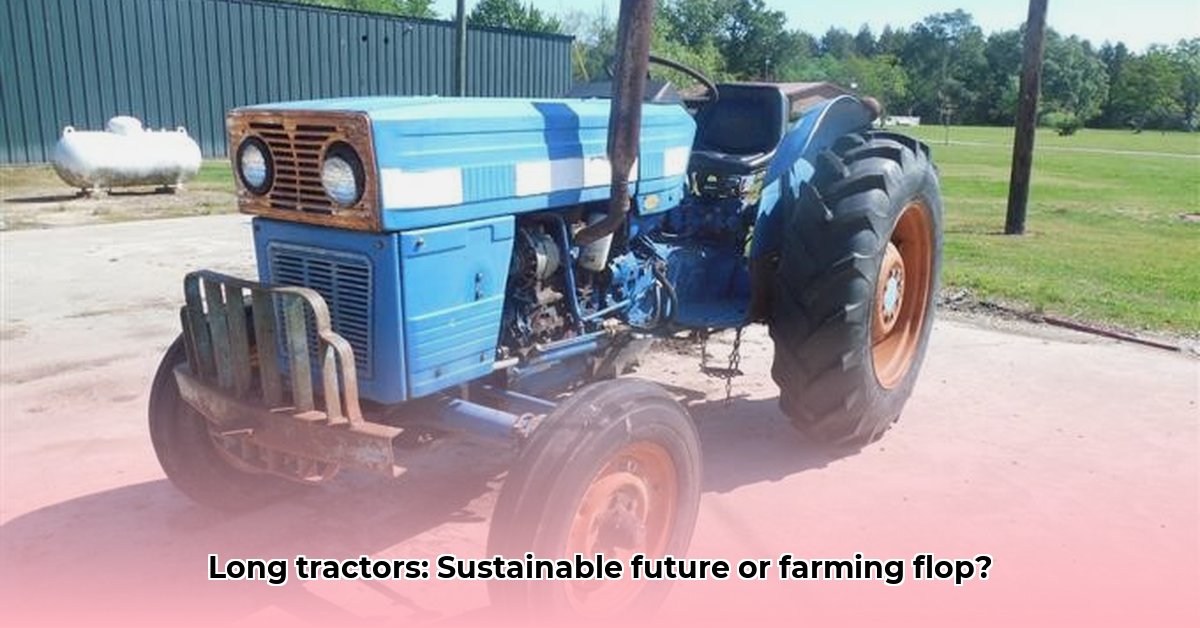
The Rise and Fall of a Farming Giant
The story of Long tractors transcends mere machinery; it's a compelling case study illustrating the intertwined evolution of agricultural technology, globalization, and environmental responsibility. Once symbols of agricultural progress, Long tractors offer a unique lens through which to examine the industry's historical trajectory. Their rise, dominance, and ultimate decline reveal crucial lessons about technological advancement, economic pressures, and the enduring challenge of balancing efficiency with environmental sustainability. What factors contributed to their success, and ultimately, their demise? This article explores the multifaceted narrative of Long tractors, examining their impact on both farming practices and the environment. For more on tractor sizes, see this helpful resource: Tractor Size Guide.
The Power of Progress: Bigger, Stronger, and the Environmental Trade-Off
Early Long tractors prioritized power and efficiency. Larger engines translated to increased plowing speed and larger harvests, seemingly a boon for farmers. However, this progress came at a cost. The powerful engines demanded significantly more fuel, leading to substantially higher emissions and a considerably larger carbon footprint. This inherent tension—between increased efficiency and the environmental consequences—remained a defining characteristic throughout the Long tractor story. Did the gains in yield justify the environmental burden? This question requires careful consideration of the historical context. In the early days, the primary focus was on maximizing output; fuel efficiency was a secondary concern. This perspective shifted over time due to evolving societal awareness, technological advancements, and increasingly stringent environmental regulations.
Did the increased yields justify the environmental cost? A key question arising from the Long tractor story is whether the significant increase in yields justified the associated environmental costs. This requires a thorough analysis of the trade-offs involved, considering the technological advancements and the environmental impact on a larger scale.
Globalization's Impact: A World of Parts and a Changing Landscape
The Long tractor narrative is intrinsically linked to the rise of globalization. Initially, production remained domestically focused. However, as market dynamics shifted, the company began sourcing parts internationally, eventually leading to the complete assembly of tractors in overseas facilities. This shift had profound consequences, influencing production costs, efficiency, and environmental responsibility. The complexities of global supply chains introduced new challenges, impacting the overall environmental impact of tractor production and distribution in ways that require further study. How did this shift affect the environmental burden associated with each tractor? Further research is needed to fully quantify the environmental impacts of this change. Some researchers argue that the decentralized nature of production could lead to less regulated processes.
Measuring the Environmental Footprint: A Complex Equation
Precisely quantifying the environmental impact of each Long tractor model presents considerable challenges. Comprehensive historical data on fuel efficiency and emissions remain scarce, hindering a precise accounting of their overall environmental contribution. Nonetheless, it is reasonable to infer that the consistent increase in engine size across various models likely resulted in a corresponding increase in fuel consumption and greenhouse gas emissions. The environmental consequences of disposing of these large machines after their operational lifespan also pose significant environmental concerns. Scrappage becomes an additional factor in the overall environmental impact equation. A complete life-cycle assessment (LCA) is necessary for a full understanding of the environmental burden associated with Long tractors. This would include a comprehensive evaluation of their manufacture, operation, and end-of-life management.
Lessons from the Past: Building a Sustainable Future
The decline of Long tractors offers valuable lessons for the modern agricultural machinery industry. Manufacturers face mounting pressure to adopt sustainable practices, encompassing the creation of more fuel-efficient machines, the utilization of environmentally friendly materials, and the development of responsible end-of-life management strategies. Can the industry successfully reconcile technological advancement with environmental stewardship? This is a critical question that demands immediate attention. The Long tractor story serves as a cautionary tale, highlighting the need for a more sustainable path forward in the agricultural sector and beyond.
Looking Ahead: A Call to Action
The following numbered steps outline a path towards a more sustainable agricultural future:
- Comprehensive Data Collection: Researchers should prioritize the collection and analysis of historical data regarding fuel efficiency and emissions for different Long tractor models.
- Life-Cycle Assessments (LCA): Conducting comprehensive LCAs for various Long tractor models will provide a more accurate understanding of their long-term environmental impact.
- Technological Innovation: Manufacturers need to invest in the development and implementation of more fuel-efficient engines and sustainable manufacturing processes.
- Sustainable End-of-Life Management: Effective strategies for recycling or responsibly disposing of old tractors are crucial to minimizing environmental impact.
- Policy Support: Governments should implement and enforce policies that incentivize the adoption of sustainable agricultural practices. This might include tax breaks for farmers who use more fuel-efficient equipment or stricter emission standards for agricultural machinery.
The legacy of Long tractors underscores the urgent need to integrate environmental considerations into the development and deployment of agricultural technology. A sustainable agricultural future hinges on finding a balanced approach that leverages technological advancements while actively safeguarding our planet's resources. Further research into the environmental impact of agricultural machinery is paramount.